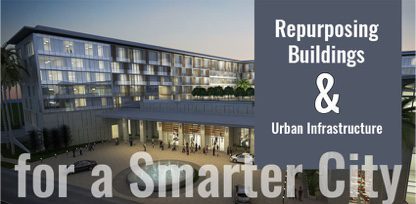Repurposing Buildings and Urban Infrastructure for a Smarter City

The smart city has many emerging definitions and the concept is touted to be the one, that will shape cities of future. All ‘smart city’ definitions encompass the idea of a sustainable, livable, intelligent and green city with continued economic growth and job opportunities for all. However, we hardly ever see the concept of adaptive reuse infused into the definition of a smart city.
Is the development of new green buildings the only way to drive our cities towards a sustainable future? What about the tons of waste generated and the energy that is invested in demolishing existing structures? Is this our concept of a green, sustainable and smart future?
Incorporating Sustainability
Nearly twenty million tons of waste and energy is sent to the Canadian landfill sites each year. One third of the waste to these landfills comes from the construction, renovation and demolition industry. The situation has deteriorated to an extent, that the amount of waste is exceeding the capacity of landfills. This has set the wheel rolling, for architects and builders, to reduce, reuse and recycle. The trend is fast catching on across the AEC industry.
A classic example of this is a recently proposed robust, comprehensive and forward-looking master plan that aims to turn an industrial estate into homes. The project proposes to build, 400 homes on a 6 hectare Phoenix industrial estate in Lewes, the county town of East Sussex. A health center, 50 extra-care flats and flexible workspace are also part of the plan. The township is going to be a sustainable, organic extension to the largest town in South Downs National Park. The project plan boasts of flood defenses and a riverside walkway. Street planting and urban swales form an impressive design feature that creates pedestrian connections between the town, and the adjacent repurposed industrial estate.

Adaptive Reuse
As cities undergo the transformative process of becoming smarter, they have to address social, economic, environmental and engineering challenges. Energy, water, waste, infrastructure, public safety, education, healthcare, green buildings, transportation and citizen services are all essential elements that form the basic premise, on which this transformation is based. In addition to these 10 essential elements, adaptive reuse of existing buildings also needs to be prioritized to save cities from the burden of demolition and disposal of waste generated from existing structures.
Repurposing or adaptive reuse, as we like to call it, will turn out to be the revolution in the construction industry; more so in the wake of current climate consciousness and sustainability efforts. The process of repurposing involves a detailed survey and a thorough put plan that chalks out details of converting existing space for a different use. Point cloud surveying and BIM are the two most popularly used approaches – rapidly adopted by the industry to meet the emerging need of transforming existing buildings for adaptive reuse.
Designing for the Future
When we talk about smart cities and designing for the future, a lot is said about erecting new buildings that are carbon neutral, green and resilient, however, it is only better said than done. Building new structures can be taxing for cities. To combat this, it is extremely important to leverage available technology and find innovative ways to reuse existing buildings and urban infrastructure, and repurpose them to fit the current needs of cities.
Hi-Tech Outsourcing Services encourages and prioritizes adaptive reuse of vacant and unused buildings, and believes that the concept is deep ingrained into the idea of a smart city. We want to create that distinction for our clients and create healthy, green and occupant friendly spaces for communities by supporting the conversion of existing buildings that are left unused into repurposed facilities.
About Bhushan Avsatthi
Bhushan Avsatthi is an Associate Director at Hi-Tech Outsourcing Services. Bhushan is a Consultant, BIM expert and a green building advisor with more than 15 years of industry experience. Bhushan imbibes the prophecy of efficient and prudent use of energy in his day to day life and advices his team to do so as well. He is also involved in green initiatives like nonprofit tree plantation project and promotes using bicycles for commuting small distances. Bhushan, handles a team of architects, structural and MEP engineers, LEED consultants and energy modeling experts.


